January 2008 Edition
industry outlook 2008
Shaping tomorrow's markets
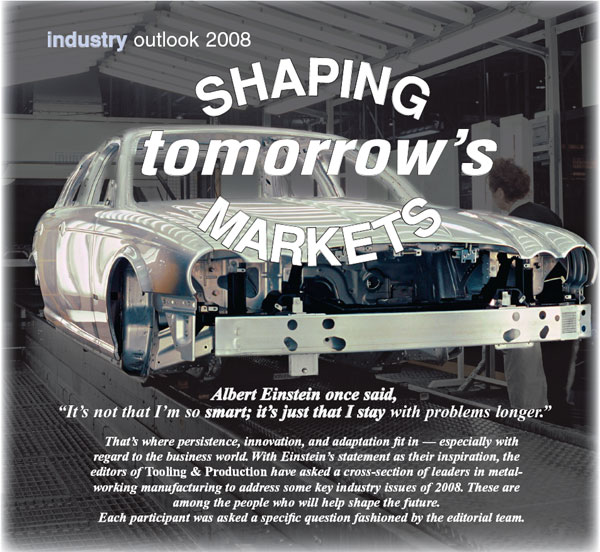
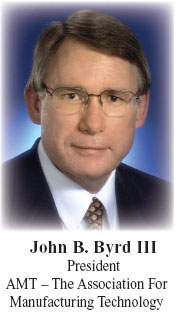
You have said: "There is a common perception that companies can simply set up shop in another country and be successful." AMT, which first opened an international office in China in 1993, knows that is anything but the case. Do you believe that more companies are beginning to appreciate that successful globalization takes a broad embrace of the partnership concept?
In order to fully appreciate global manufacturing, one must accept that the manufacturing economy consists of two very different sectors: production of commodity goods and durable-goods manufacturing.
Commodity goods manufacturing is generally low-skill, labor-intensive manufacturing that will flow to areas of low wages. Unless the volume can justify implementation of advanced manufacturing technology, this work is generally accomplished through the use of manual labor and favors countries that haven't developed an integrated manufacturing economy.
While low-cost countries do compete in durable goods manufacturing, durable goods production normally follows demand because the supply chain has become very compressed as manufacturers strive to reduce costs. Durable goods are high-value-added products that are made to exacting specifications in an assembly line environment. Therefore, in the durable goods manufacturing supply chain, lead time is critical, technology is essential, and productivity is a competitive advantage.
Because almost 90 percent of the global demand for manufacturing technology products lies outside the United States, U.S. manufacturing technology providers are becoming increasingly global as they strive to participate in growing markets such as China and India. They recognize they must be there not just in spirit but also in fact, and are rapidly developing a local presence not only by setting up local offices and manufacturing facilities, but also by developing strategic alliances and joint ventures. This is the business model of the future.
Meeting the needs of ever more demanding customers requires more than simply selling advanced technology. Manufacturing technology providers must develop a mind-set that they are partners with their customers, jointly seeking solutions to the customers needs.
To compete in this environment, manufacturing technology providers must be prepared, not only to sell their products in every local manufacturing economy, but also to support the product after the sale. This can be a significant challenge in a foreign country if the company's representatives don't speak the language, fail to understand the laws and customs of the host country, and, most importantly, lack understanding of local business practices.
Today, there is a growing recognition among U.S. companies that, just as U.S. manufacturers won't accept foreign products without local support, foreign manufacturers expect the same degree of support in their local markets. In short, just as durable-goods production follows demand, manufacturing technology providers that provide support in the local markets and can provide a competitive advantage to local manufacturers will see demand for their products around the world.
Many companies have learned this lesson as they struggled to compete in an environment they didn't understand. The successful companies learned from their early mistakes; the unsuccessful companies never developed an understanding that manufacturers everywhere in the world expect local support.
Because almost 90 percent of the global demand for manufacturing technology products lies outside the United States, U.S. manufacturing technology providers are becoming increasingly global as they strive to participate in growing markets such as China and India. They recognize they must be there not just in spirit but also in fact, and are rapidly developing a local presence not only by setting up local offices and manufacturing facilities, but also by developing strategic alliances and joint ventures.
This is the business model of the future.
AMT – The Association For Manufacturing Technology,
www.rsleads.com/801tp-157

Warren Buffet's investment into Israel-based Iscar Metalworking Companies (IMC) was a major attention-getter throughout the business world. But IMC also took over Unitac last year — the first non-Japanese cutting-tool manufacturer to acquire a cutting-tool manufacturer in Japan. You've said: "Our culture allows us to work easily with other cultures around the world." Is that attribute increasingly becoming an important metric to success in global manufacturing?
The world market is expanding over the last few years with the high investments in the emerging markets, including China, India, Russia, and Eastern Europe, and is consequently experiencing sustained growth in exporting markets in Western Europe, Japan, and North America.
Looking forward, we foresee growth in all segments relating to aerospace, power generation, oil and gas, machine tool builders, medical and general engineering relating to both the emerging and the exporting countries. This positive trend will also result in an enhanced competitive environment. In this context, Iscar's continuous introduction of new pioneering and innovative products provides our customers with the tools to further improve their productivity and to be able to compete more successfully in this competitive global environment.
To address the challenges of our customers to achieve sustainable increase in productivity, Iscar is introducing a revolutionary new metalworking concept for increased productivity called 3P Sumo lines. This concept presents Premium Productivity Products (3P) for better productivity, better profitability, and better performance. The highlight of the 3P introduction is the Sumo Tec products feature a new series of premium tungsten carbide grades to meet the machining challenges of the metal cutting industry. Complementing Sumo Tec, Iscar has developed a new series of tools and inserts branded Sumo Lines.
Furthermore, Iscar's purchase of Unitac/American Heller of the USA and Japan is another indication of Iscar's commitment to introduce to the market the most comprehensive program and solutions for the most demanding applications within the industry. We believe that by adopting the 3P, companies will be better positioned to compete and gain a higher share of their respective market.
The success in 2008 of any company in United States and elsewhere is directly related to adopting the latest technology.
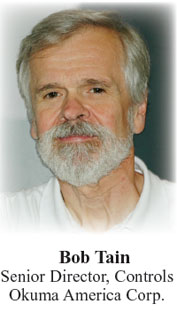
When Okuma introduced THINC – The Intelligent Numerical Control – the corporation pointed out that "the classic model of CNC design, implementation, and use is obsolete." Okuma also said its shift in thinking is based on a few basic precepts. Please elaborate on those precepts – and comment on how those precepts may, or may not, apply to the industry in general.
Okuma sees a direct correlation between biological evolution and machine tool control evolution. As time progresses, biological systems and control systems must evolve more quickly to remain competitive in the ecosystem. CNC has reached an evolutionary dead end. It is obsolete and ready for extinction.
In 1998, the Okuma Precept was proposed and adopted as an axiom of the corporation.
The classic model of CNC design, implementation, and use is obsolete.
This precept is based upon four basic laws of industrial computing which Okuma collectively christened as the Red Queen Inference. These basic laws are the foundation of THINC, The Intelligent Numerical Control. THINC is a disruptive technology in the sense defined by David Bader, executive director of high performance computing at Georgia Tech who says, "It's only when you have disruption of the status quo that new innovations can affect technology with revolutionary advances."
[Here is] the Red Queen Inference:
- The end user of machine tools must have the freedom to customize the control environment independent of the OEM in order to adapt to changing environments and requirements.
- Industrial computers for machine tool control must inexpensively and easily pace the general computing market even after installation on the factory floor. The machine tool control must evolve with new technology on the factory floor.
- Machine tool controls must be fully and absolutely compatible with the de facto computing environment of the general computing industry.
- Machine tool controls must incorporate a robust and user-friendly set of application programming interfaces to allow the end user or a third party to develop software to influence machine tool operation allowing a more productive environment and thus higher profitability.
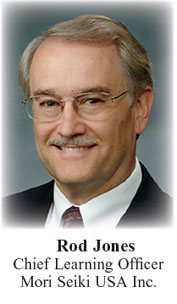
Late last year, the International Skills Festival selected Mori Seiki as an official supplier. And Mori Seiki took a novel approach to applying e-learning in manufacturing with the 2007 introduction of Education on Demand. Give us your thoughts on why the industry needs to maintain a workforce capable of capitalizing on the benefits of cutting-edge technology.
How do we compete in a global economy that has lower labor costs? The obvious solution is strategically investing in hyper-productive machinery. However, there is a growing problem with this strategy. Are the skill levels of those who must sell, apply, program, operate, and maintain today's CNC machines up to the task? The truth is, we are facing a growing skill gap and it affects everyone in the chain – suppliers and manufacturers. As our schools struggle to recruit and educate high-performance workers, the task falls on industry.
The machine tool innovation Mori Seiki is delivering to customers is breathtaking. However, maximum productivity is limited by the human capital that surrounds the machine. Training is the answer – the only answer. Historically, machine tool suppliers view employee and customer education as a necessary evil. Not at Mori Seiki. We are dedicating significant resources to creating a learning culture, led by Mori Seiki University. However, even if training is available, will customers take full advantage? The answer is generally no. In fact, the average U.S. manufacturer typically spends less than 1 percent of worker time in training. This compares to 5 to 10 percent for highly competitive manufacturers.
There is only one thing worse than training an employee and having them leave: it is not training them and having them stay!
The reasons most don't train are simple. Training is expensive when you consider taking operators off machines and sending them to training classes. Lost production, missed schedules, paid overtime, and travel expenses are all training-cost factors. What is the answer?
Mori Seiki University has the solution. Provide blended learning through the use of classroom, on-machine, and online educational opportunities. Our web-based Education-On-Demand delivers realistic, emulation-quality operator education at the point of need. Available 24 hours a day, seven days a week, it reduces cost, engages employees and provides an educationally sound training experience that complements face-to-face training. This is not only the solution; it is the future of education for manufacturers.
There is only one thing worse than training an employee and having them leave: it is not training them and having them stay!
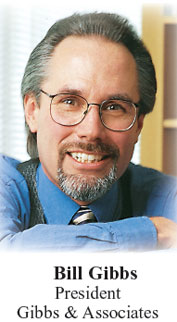
As far as production machining is concerned, would you call ours the Age of Five-Axis Machining? From your perspective as a provider as a CAD/CAM technology provider, what are you seeing?
No. I probably should explain. I guess your term "five-axis machining" refers to simultaneously milling with five-axis mills, consisting of three linear and two rotary axes. Certainly there is more of this being done these days, but I'm not sure that should qualify as being "the age of."I would say this is "the age of high-efficiency production machining," which is the best way to compete with low labor rates elsewhere in the world. I would put several machine technologies in this group, including any machine that can reduce the number of setups normally required with traditional single-task mills and lathes. We can start with your simultaneous five-axis milling. This can replace a number of separate three-axis setups. Also of great potential is the four- or five-axis horizontal mill with pallet changer and multi-part tombstone fixturing.
While also capable of rotary milling, the primary value of these machines is in machining three to five sides of parts arrayed on large fixtures. Once the domain of high-volume production only, these machines can be used for just-in-time, low-volume manufacturing. Come in on a Monday, look at the orders to fill, use a tombstone management CAM software such as GibbsCAM to populate any number of tombstones with preprogrammed individual parts, set up enough for the week, and let the machine run 24/7, changing pallets as necessary.
I would say this is ‘the age of high-efficiency production machining,' which is the best way to compete with low labor rates elsewhere in the world. I would group several machine technologies in this group, including any machine that can reduce the number of setups normally required with traditional single-task mills and lathes. We can start with your simultaneous five-axis milling. This can replace a number of separate three-axis setups. Also of great potential is the four- or five-axis horizontal mill with pallet changer and multi-part tombstone fixturing.
My favorite high-efficiency machine is the multi-task machining (MTM) machine tool consisting of multiple spindles, multiple turrets, and frequently five-axis milling capabilities as well. Material is bar fed, milled, and turned on all sides to come out as a finished part without being touched by human hands with the added benefit of higher quality.
With good MTM CAM software, such as GibbsCAM, you don't need a large volume of parts to justify the low part programming and setup costs. With reduced labor costs, you can compete with any CNC manufacturing location in the world.
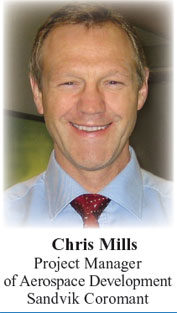
New generations of insert grades are greatly enhancing machining efficiency in terms of productivity optimization and application versatility. What should the metalworking market expect in the next few years?
Our goals in aerospace are the same as in the many other areas where we work actively to support our customers. Regardless of segment or size, our goal with every customer is to work as a partner and add value far greater than the product themselves, focusing on their individual needs to deliver the lowest total manufacturing costs. What makes aerospace special is that it presents a very unique collection of challenges. Engineers must view aerospace manufacturing as athletes view the Olympics or mountaineers view Mt. Everest. It's the ultimate challenge.
While there are many aspects to aerospace manufacturing, three currently stand out as particularly demanding.
Materials such as nickel and titanium alloys and composites have very low machinability. Optimized tools are required and programming methods have a tremendous impact.
Parts are often extremely large, yet feature the thinnest of walls and incredibly complex geometries.
High fatigue life is imperative and the part surfaces generated by the cutting tools must have the integrity to withstand a given number of flying hours.
This combination of factors dictates a production environment consisting of complicated four- and five-axis machines driven by CAM. High component costs allow for no mistakes, so advanced verification programs must be used to avoid collisions and ensure that a part is correct the first time. It can take weeks to develop a process and actual part production time can run into the hundreds of hours.
Engineers must view aerospace manufacturing as athletes view the Olympics or mountaineers view Mt. Everest. It's the ultimate challenge.
Sandvik Coromant has developed a variety of solutions to features and components typical within the aerospace industry. We work together with customers to apply these solutions to their production, predicting and guaranteeing the cycle time and tool life. This ensures that when the part is processed in CAM, the implementation time is short with minimal need for changes. We also offer to work with customers as early in the process as possible. By concentrating on tooling and machining processes at the beginning of planning for a new job or machine, potential pitfalls can be sidestepped and avoided.
With our solution capabilities and knowledge of the challenges facing aerospace manufacturers, we can confidently promise cost reductions, normally in excess of 30 percent. This challenge motivates us to constantly improve our processes and stay at the forefront of innovation.
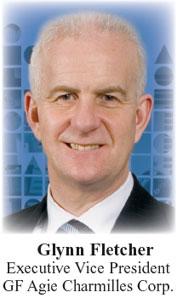
GF Agie Charmilles introduced 100% Service, a comprehensive support system that maximizes machine life and performance through the "inclusion of preventive maintenance contracts and original parts and consumables." As it has been said of quality, is service a race without a finish line?
As market conditions and technological innovations are constantly changing, so must a company's efforts toward providing customers with the highest possible levels of service. As our customers' business models and production practices evolve, their needs and expectations shift as well. For this reason, service is indeed a race without a finish line.
As described in Jeff Thull's book, The Prime Solution, a "value gap" is created when customers perceive a less-than-expected return on an investment. Within the manufacturing industry, a machine not being operated to its true, full potential can often cause this. In other words, producing a world-class machine is not enough if we do not help our customers receive the maximum benefits. To achieve more.
In 2007, Agie Charmilles established 100% Service, a comprehensive initiative that focuses on maximizing customers' return on investment in every possible way. The initial key targets were derived from some startling market data. Seventy percent of machine downtime is caused by a lack of preventive maintenance. Fifty percent of the average machine's potential is untapped because of inadequate operator training. Twenty percent of machine downtime is a result of not using original parts and consumables.
As described in Jeff Thull's book, The Prime Solution, a ‘value gap' is created when customers perceive a less-than-expected return on an investment. In other words, producing a world-class machine is not enough if we do not help our customers receive the maximum benefits.
When looking at the previously mentioned issues, we see that they are caused primarily by progress. As machines have become more advanced, preventive maintenance has grown in importance and the lack of it can cause greater problems. Radically new innovations require increased efforts toward providing necessary training to the operators who will be using them. Additionally, refinements in machine design have multiplied the importance of using parts and consumables specifically created to capitalize on a machine's unique abilities. Without evolution, a service program that perfectly met customers' needs a decade ago may now be lagging behind their needs.
Avoiding the "value gap" is vitally important to maintain a partnership that truly benefits our customers. To do this, we must constantly be proactive when introducing changes to our products, when analyzing shifts in market trends, and, most important, when seeking feedback from our customers.
In essence, the key to our own success is the success of our customers.
Today, this idea is important to our progress. In the future, it will become, without doubt, our most fundamental and overriding advantage. Service may well be a race without a finish line but that doesn't mean that there cannot be a winner. Winners in the service race will be conspicuous because they will be the winners overall.
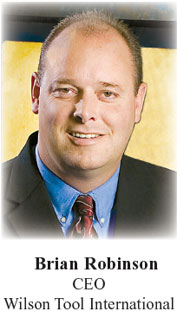
You've said: "I've always believed that if you're not creating change, you're falling behind. As the world gets flatter and faster, we'll continue to adapt and innovate to meet the needs of sheet metal fabricators worldwide." As the new CEO of Wilson Tool, how are you actually accomplishing that?
Manufacturing is now a global game and the heightened competition has a tremendous impact on how sheet metal fabricators approach their business. To survive and thrive, they must adapt and innovate to a new way of thinking. There are a number of ways that Wilson Tool is helping our customers achieve that.
First, we know that well-designed tooling innovations greatly improve the productivity of fabricators, and that Wilson Tool is uniquely positioned to provide those solutions. Innovation is ingrained in our culture – it's an expectation in everything we do. Our customers have come to expect us to lead the way with groundbreaking tool design and fresh thinking. It's a continual process of producing longer-lasting, more efficient tooling. But they also count on us for unsurpassed support in the form of customer service, faster lead times, and training.
The way we accomplish all this is no mystery: we listen closely to the voice of the customer. Our research and development is directed toward the specific needs of our customers. When they tell us they need better tooling performance for an application, our engineers go to great lengths to find the best solution. And if the solution doesn't exist yet, we'll often engineer a completely novel approach to fill that need.
Innovation is ingrained in our culture – it's an expectation in everything we do. Our customers have come to expect us to lead the way with groundbreaking tool design and fresh thinking.
Another way we're adapting to this highly competitive environment is through lean manufacturing. Lean is central to everything we do, and our award-winning program helps us build on our market-leading strengths such as quality, delivery times, and customer service. It also helps us rein in costs, which ultimately benefits our customers.
We're now using our lean knowledge to educate fabricators to be more successful. We can look at their production floor and advise them on how to apply lean concepts to boost efficiency. We're also planning lean training sessions at the Wilson Tool Technology Center, where sheet metal fabricators learn how we can help them be more competitive and deliver superior quality to their customers.
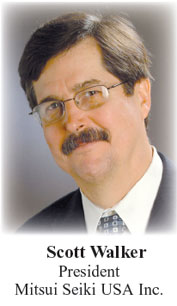
As you have said many times, volumetric accuracy — the sum of positioning, straightness, wobble — influence how accurately the tool tip moves through the travels of the machine. "That number," you've said, "should be a value — for example 20µm, 12µm, 50µm — that reflects the machine's true positioning accuracy. It should be based upon a world standard, not simply a standard established by machine tool builders." Are we any closer to that standard? And why do we need it?
In the days before pre-loaded ball screws, machine tool positioning and repeatability were directly related to how well the lead screw was made. Because of that history, positioning and repeatability are still very large numbers to this day. For example, it might be published that a machine tool can position to 40 millionths and can repeat to 80 millionths, and those specifications are what a lot of builders and buyers still use to define machine tool accuracy. Those specs are not a true indication of current machine tool technology. With the proliferation of pre-loaded ball screws, especially adorned with glass scales, a machine will hit 40 millionths without any problem on any one axis.
The problem is, when manufacturing three-, four-, and five-axis high-precision components, users need considerably more information as to what is occurring in the cube of the machine. For example, what is the spindle parallelism to the table? What is the table wobble? What is the straightness of axis travel? What is the spindle runout? There is a long list of geometrical specifications that are paramount to producing accurate parts, all of which add up to volumetric accuracy.
Machine geometry is a function of moving a certain amount of mass along the way system. This movement of mass needs to move straight without pitch, yaw, and roll because any variation of these three movements is amplified as travel goes further and further along from the machine tool's way system to the outer edges of the work envelope. Volumetric accuracy is the sum of positioning, straightness, wobble – all of those characteristics that are inherent in how accurately the tool tip moves through the travels of the machine. Therefore, for part production, this concept is very important.
Without precise volumetric accuracy, the machine tool will produce unacceptable parts. Typically, the machine's dynamic volumetric capability should be at least 50 percent to 80 percent tighter than the part tolerance. In high-precision machining, most users need an 80 percent capability.
Volumetric accuracy should have a number associated with it so that buyers can compare machines. And that number should be a value, for example 20µm, 12µm, 50µm – whatever is the true positioning accuracy of the machine. That value number should be a national standard, not simply a standard established by machine tool builders.
I don't care who comes up with the standard, but there is a requirement that all should agree on that boils down to a number so that people can say, "I need to buy a machine tool with a volumetric accuracy of…." as in the old days they could say, "I need a machine that can repeat to a thousandths, or position to a thousandths."
The standards committees are working on the definition of volumetric positioning accuracy. A complete definition of the volumetric accuracy requires the measurement of many elements and is difficult to define. There are systems that use four body-diagonal displacement errors to define the volumetric positioning error but it is not 100 percent accurate.
This discussion has been going on for far too long, and it needs to be resolved. Granted, it is an immensely complex subject. Some of the best theoretical brains in the industry are on these committees. As a manufacturer of what are arguably the most precise machine tools in the world, such as "mother" jig boring machines and thread grinders, along with custom CNC machining centers, Mitsui Seiki has been able to define volumetric accuracy by taking 20 geometric measurements on our machines.
However, that's our culture and our customers' requirements. Most other builders are not geared for that, so the standard needs to something less complicated, more understandable, and something that everybody agrees on, and that's what is tough. In the committee meetings, it doesn't take long for the conversation to become convoluted, murky, and no one can agree. When you get into standards, agreeing on anything is extremely difficult because of the governmental implications. It's a bureaucratic quagmire.
In my opinion, we can simplify the concept by establishing a specification number by which to compare equipment. For example, the difference between machines A, B, and C, would be a value, of perhaps 1, 2, 3, 4, or 5, with 1 having the greatest volumetric accuracy, which again is true position in the cube, and 5 having the least. To make it more palatable, those numbers could represent a range; for instance a 1, which would be in the Mitsui Seiki realm, could be from 5-15µm.
Everyone does agree on one point, however – knowing a machine's volumetric accuracy is important for a manufacturer of precision parts to understand.
That makes sense; however, the next logical question is what is the methodology for proving that range. One way to do it is to measure every micron position in the cube. It takes forever to do, but it'll convey exactly what the volumetric accuracy is. I don't think a builder needs to do that. I think it really comes down to straightness of travel. In a horizontal machining center with 900mm travel, if straightness of travel is under 2 arc seconds in X, and you square up, the three axes positioning accuracy is at 12µm. If it's 2.5 arc seconds, it's 15µm. If straightness is 3 arc seconds, positioning is 20µm. An arc second is an angular measurement. There are 60 arc-seconds in one arc-minute, 60 arc-minutes in one degree, and 360 degrees in a full circle.
That has been our experience at Mitsui Seiki. An optical device called an autocollimator is used to analyze the pitch and yaw. By looking through this telescope-like device, one can detect misalignment by the position of the cross hairs in the autocollimator's sight. Movement of the cross hairs up and down indicates pitch error, whereas movement left or right indicates yaw error in the way surface. Roll error is measured with a precise spirit level. Typically, the autocollimator is moved 100mm along the way surface to measure pitch and yaw error at each interval. Then the spirit level is moved along the way system to measure roll error at the same interval.
Anyone can argue, especially me, that there are other variables. There is table wobble; thermal distortion; bend, spindle run out and stiffness; and a host of other issues that affect this. That's why it's been impossible to resolve. I say, simplify it. Keep it as a measurement of travel straightness and be done with it. As long as everyone knows the other factors that can affect it, it's still a fair way for a user to compare the precision of a machine tool and much better than the way we communicate accuracy now. It's a starting point.
Everyone does agree on one point, however – knowing a machine's volumetric accuracy is important for a manufacturer of precision parts to understand. One of the most troublesome challenges manufacturing engineers and managers face is a machine tool that fails to produce accurate parts. Wouldn't it be helpful to know what a machine tool's volumetric accuracy is before you purchase it?
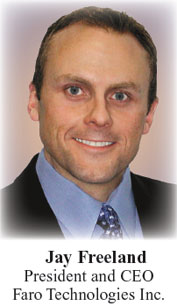
As a company serving the large computer-aided manufacturing measuring market, Faro deals with aerospace, automotive, and heavy-equipment manufacturers, among others. What markets look particularly promising over the next 12 to 18 months and how is a company such as Faro responding to those markets' needs?
When we acquired our Laser Scanner LS technology, Faro changed from being a manufacturing measurement company to a company that could measure anything in any industry. We can penetrate markets that include everything from factory planning and asset documentation, specialized applications ranging from surveying, recreating accident sites and crime scenes to digitally preserving historical sites.
But what we're most excited about is the new opportunities afforded us by the release of our Quantum and Fusion FaroArms. The Fusion has accuracy in the 43µm range. The existing Platinum FaroArm has accuracy of the 25µm range and the Quantum is in the 17µm range – a significant differentiator that is unique to the marketplace today.
What that means to our customers is that Faro will be able to provide a broader application range in facilities that require higher accuracy or lower cost thresholds, and we'll also be able to expand into markets where only stationary CMMs fit the accuracy quota before. Medical device and bearings manufacturers, just to name two, didn't believe that portable could get them to where they needed to be.
The Quantum changes that. Applications that we heard auto and aero industry customers talk about, folks needing CMM accuracy but wanted to move it around the entire plant floor, had just been waiting for this technology. There was a distinct differential between that 25µm and 17 barrier in terms of the number of opportunities that open.
Generally speaking, 25 percent of our customers are large Fortune 500 types of companies; 75 percent are smaller, second- or even third-tier companies that either sell into their own markets directly or are part of the supply chain feeding the larger-end manufacturers. Globally, we have customers as large as Boeing – which signed a huge Faro Laser Tracker order in Q3 – down to individual one-man machine shops that buy Faro Gages. So we really have a broad spectrum of users.
The markets we serve remain highly fertile ground with significant opportunity and I believe we have only scratched the surface.
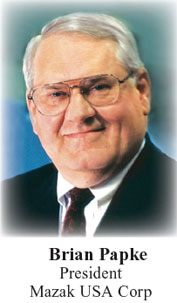
Mazak has successfully implemented Production-On-Demand, a pull-through manufacturing system. It's now evolving now to High Production-On-Demand.
The goal is to maintain the same excellent quality, the same efficiency, yet increase the number of machines Mazak is producing in Kentucky for U.S. customers and for export. Please give an update on the progress of this manufacturing strategy.
At the core of Mazak's manufacturing strategy is continuous investment in advanced technologies and automation within our own factories. Over the most recent period, investment has focused on multi-axis technologies, from our Variaxis mid-size machines to larger Integrex multitasking models and our largest machining center yet, the V140N five-axis. Every new machine we implement is 40 to 70 percent more efficient than the one it replaced. Further productivity improvements in our Florence, KY, operations have been gained by automation including robotic machine tending and our own Palletech palletized machining cells.
These new technologies allow us to combine more operations on fewer spindles thereby requiring less manpower during the machining phase of producing machine tools. As a result, we have been able to cross-train our personnel and utilize them in assembly and quality operations, increasing shipments without raising employment proportionally as in the past. Specifically, our unit production has risen approximately 20 percent over the last two-year period, with 100 fewer manufacturing people.
Not only have shipments increased, but many new products have been introduced, adding more value to our product mix and opening more market opportunities for Mazak. Because our Production-On-Demand strategy begins in engineering with designs that are modular and efficient to produce, we are able to develop and integrate new products rather seamlessly. We have introduced three new Nexus multitasking turning centers over the period, one being the largest ever produced in Kentucky and targeted for the energy services industry and other manufacturers of large parts. Two new Nexus vertical machining center models have also been introduced, one for five-axis machining and another for larger parts machining.
A small but growing portion of our U.S. production is being exported outside of North America. The combination of our increasing efficiency and the weakening dollar are making such opportunities much more attractive, and we are able to respond.
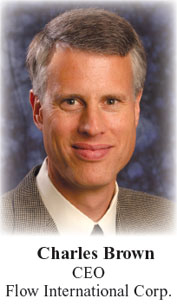
Waterjet technology is a perfect example of how advanced metalworking manufacturing has become. As CEO of Flow International, how do you continue to nurture further technological advancement?
Flow origins are as an advanced technology R&D incubator, and we've grown at a pace that matches our innovation. Whereas most heavy-equipment manufacturers settle for growth that roughly tracks GDP, we've grown at 12 percent CAGR [compound annual growth rate] over the past three years. That kind of growth is befitting of a technology company that serves a rapidly growing market that's still only in the early adoption phase.
Flow developed the waterjet in the 1970s when the founders of the company – former Seattle Boeing aerospace engineers – discovered that water applied at ultra-high pressures could be used to cut materials as strong as steel and up to a foot thick.
In the late 1990s, we moved from innovation to the early adopter phase, which is where we are today as the world's largest waterjet cutting manufacturer, with some 40 percent of the worldwide waterjet cutting market. We have a base of more than 8,500 installed machines in 45 countries, with no single customer representing more than 5 percent of total revenues. Perhaps most significantly, we penetrate well under 10 percent in most of the growing list of industries that we serve. We estimate that the global market for waterjets is more than twice as large as it is currently, approaching $1 billion per year.
When fuel prices began to skyrocket, the military and aerospace industries quickly began switching to stronger and lighter composite materials. Unlike traditional cutting technologies such as saws, blades, or lasers, UHP water can cut virtually any material, in three dimensions, without altering the makeup or integrity of what's being cut.
We are the only manufacturer to invest in the next generation of waterjet technology to take us into new markets. We are the only manufacturer to offer an industry-leading 87,000psi machine, which is more than 30 percent faster than its 60,000psi predecessor – also an industry first from Flow. We also offer dynamic waterjet cutting, which produces more accurate parts at significantly higher cutting speeds than parts cut with a conventional waterjet. Flow also recently rolled out a MicroJet precision waterjet, which offers breakthrough accuracy that is ideally suited for the medical device industry and other markets that demand the highest levels of accuracy.
When fuel prices began to skyrocket, the military and aerospace industries quickly began switching to stronger and lighter composite materials. Unlike traditional cutting technologies such as saws, blades, or lasers, UHP water can cut virtually any material, in three dimensions, without altering the makeup or integrity of what's being cut.
We're showing the world the superiority of waterjets. Innovation is our legacy and our future.
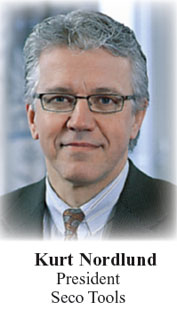
Seco builds its business strategy around what it calls "customer intimacy." Please explain.
It is no secret that the manufacturing environment has become increasingly competitive as outsourcing and globalization spread. We don't believe that U.S. manufacturers can be successful by offering the lowest priced commodity, even though that may secure a spot on the approved vendor list in purchasing.
To compete effectively in today's manufacturing environment, we believe suppliers must be business partners with a vested interest in improving their customer's operations. Companies need to offer cutting edge technologies in combination with service, support and quality that can't be met by outsourcing. Customers need local suppliers who can quickly and easily understand their individual needs – where they have struggles. This takes close contact and involvement.
From this we can realize the power of listening to, understanding, and addressing the customer's issues. This is what Seco refers to as customer intimacy. Support and solutions are made available on the customer's conditions, where we take a long, hard look at what they individually need to accomplish. And, via the right combination of cutting tools, service offerings and application support, we invest the research and time to optimize their machining processes.
Our Seco Business Solutions (SBS) plays an important role in this. SBS is a value-added offering of service provisions made available to Seco customers for the purpose of improving their profitability – from web-enabled inventory management to downloadable Seco software to Productivity Cost Analysis to on-the-road training.
From our perspective, globalization is positive. You just need to act locally. With Seco operations in over 40 countries, we are investing internally to collect best practices from around the world to develop a central repository of optimized customer applications that can be shared across the global organization.
Technology develops at such a rapid rate that organizations cannot keep up, creating a technology gap. By offering distributor and customer education programs, we enable companies to stay abreast of the latest product development and processes to maximize their machining productivity.
From our perspective, globalization is positive. You just need to act locally. With Seco operations in over 40 countries, we are investing internally to collect best practices from around the world to develop a central repository of optimized customer applications that can be shared across the global organization. At the same time, we are building a new U.S. headquarters that will feature a state-of-the-art tech center and training area to support our NAFTA customer application needs
Through this approach, customers gain access to ideas and other customer case histories via internal and external networking. This results in better service and swifter suggestions for the customer in the machining processes. Dedication to customer needs also means development of the customer's effectiveness in productivity improvement as well as cost savings. The result is better business and increased competitiveness for all.
Also through this approach, customers will see we are not just focused on today, but on continual improvement to meet the challenges of the manufacturing world to come.
What do you think?
Will the information in this article increase efficiency or
save time, money, or effort? Let us know by e-mail from our
website at www.ToolingandProduction.com or e-mail the editor at
dseeds@nelsonpub.com.